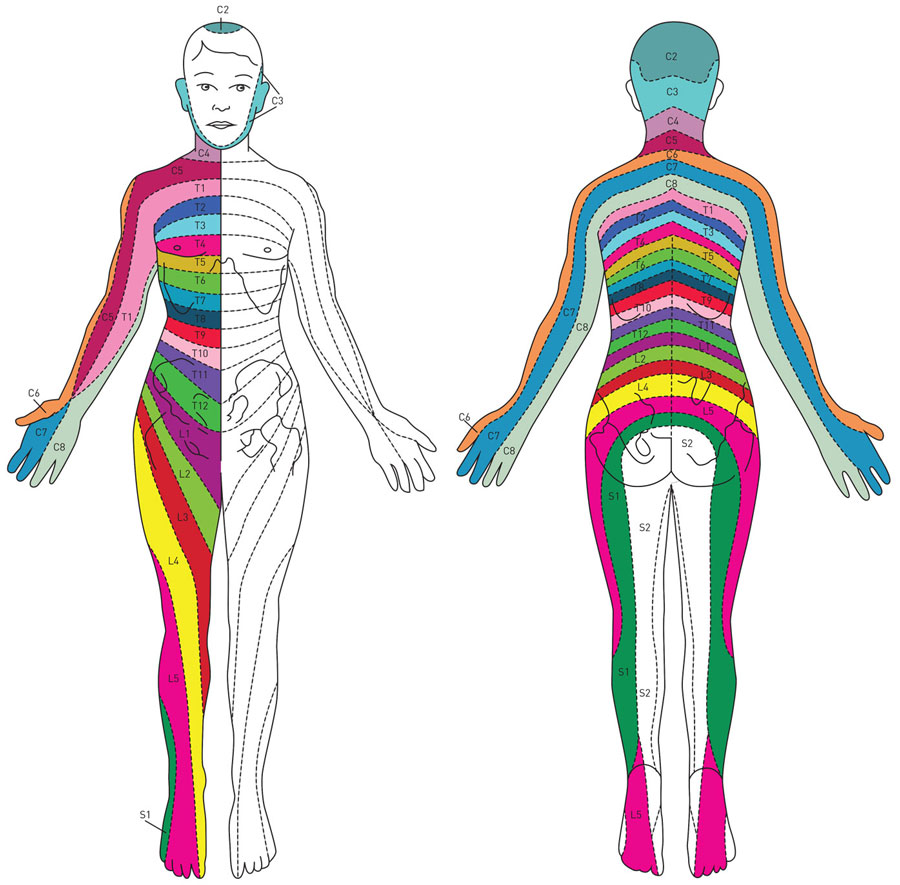This blog is excerpted from a National Spine Health Foundation article, sourced December 6, 2021.
Knowing the anatomy of your spine is important. But what exactly is a healthy spine? What are the parts of a spine?
The spine is an extraordinarily complex structure made up of a lot of moving parts. It is extremely flexible. No matter how you are standing, lying, or positioning yourself, your spine has strain on it.
The Human Spine Anatomy
The entire spinal column consists of 33 individual bones called vertebrae plus 2 sections of naturally fused vertebrae, the sacrum and the coccyx, located at the very bottom of the spine which are also an important part of your spine’s ability to function properly.
When we talk about the spine, we often call it the vertebral column because it is literally a column made up of vertebrae! The spine-the vertebral column-can be divided into 5 regions:
- The Neck, or Cervical spine: These are the first 7 vertebrae in the spine which occur in the neck (C1-C7)
- C1 is the atlas.
- C2 is the axis.
- The Back, or Thoracic spine: These are the 12 vertebrae of the mid-back that are attached to your ribs (T1-T12)
- The Lower Back, or Lumbar spine: These are the 5 vertebrae of the lower back (L1-L5)
- The Base of the Spine, or Sacrum: This shield shaped bone carries all the weight of the body, and is the site for many muscles and ligaments to attach to in the hip and pelvic region of the body
- The Tail-bone, or Coccyx: This tiny bone comprised of 4-5 fused small vertebrae supports sitting and weight bearing
The primary functions of the spine include:
- Protecting the spinal cord, nerve roots, and internal organs
- Providing the flexibility of motion
- Providing structural support and balance for upright posture
Cervical Spine Anatomy
The neck, also called the cervical spine, is a well-engineered structure of bones, nerves, muscles, ligaments, and tendons. The delicate structure of the cervical spine, which houses the spinal cord, is very strong and flexible. This allows the neck to move in all directions.
The cervical spine has seven stacked bones called vertebrae, labeled C1 through C7. The top of the cervical spine connects to the skull and the bottom connects to the upper back at about shoulder level. As viewed from the side, the cervical spine curves toward the front of the body and then backwards. This natural curve is anatomical important for managing the weight a pressure from the skull.
Anatomy of the Thoracic Spine
The thoracic spine is the longest region of the spine, and by some measures, it is also the most complex.
It creates a connection between the cervical spine and the lumbar spine. It also runs from the base of the neck to the abdomen, making it the only spinal region that attaches to the rib cage. Some of the thoracic spine’s most important roles include protecting the spinal cord and anchoring the ribs. While the cervical spine and lumbar spine are built more for mobility, the thoracic spine is built more for stability.
Lumbar Spine Anatomy
The lower back includes the five vertebrae in the lumbar region and supports much of the weight of the upper body. The lumbar vertebrae are physically the largest bones of the entire spine, with cervical being the smallest and size increasing as the spine descends.
All of the vertebrae have space between them that includes intervertebral discs that act as shock absorbers. These gelatinous cushions protect the vertebral bones as the body moves. Ligaments hold the vertebrae in place and tendons attach the muscles to the spinal column. The lumbar spine consists of five moveable vertebrae, numbered L1 through L5. The lumbar area is often affected by heavy lifting, sitting for too long, wearing improper shoes, and more. It is the most common part of the spine to cause disability that prevents people from going to work due to back pain.
What Should I Do If I Feel Back Pain?
Keeping your physical health up to date and keeping your body healthy for years to come is extremely important. Back pain can come from disease in the discs, from trauma to the vertebrae, from arthritis in the many joints in the spine, from systemic conditions like osteoporosis, and others.
If you’re suffering from debilitating back or neck pain, we can provide a complimentary review of your case to determine if you are a candidate for our exclusive Bonati Spine Procedures. We do not advocate for or perform surgeries where hardware, devices, stimulators, or disc replacements are inserted into the spine. The patented Bonati Spine Procedures are targeted, precision outpatient procedures performed on an incremental basis to pinpoint and eliminate the main causes of back or neck pain one level at a time. We have been able to help thousands of patients who were told nothing can be done for them and patients after failed surgeries from other facilities. Simply call 844-663-0310 or complete our contact form here and a Bonati patient advocate will be happy to reach out to you directly to discuss.
Read the full National Spine Health Foundation article here: https://spinehealth.org/spine-anatomy/

